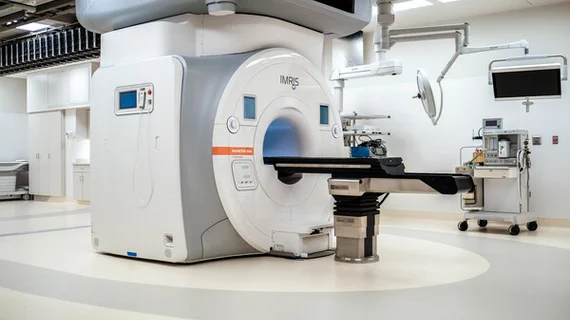A first in pediatrics: Hybrid intraoperative MRI neurosurgery suite
Children’s Minnesota recently celebrated the opening of a hybrid intraoperative MRI neurosurgery suite, which enables doctors to perform brain and total spine scans mid-procedure for surgeries involving brain tumors, epilepsy, traumatic injuries and more. The suite is the first of its kind in the United States, according to a recent announcement about the opening.
To maximize efficiency, explained Meysam Kebriaei, MD, medical director of the neurosurgery program at Children’s Minnesota, one room in the suite is set up to allow a patient on the operating room table to be moved into the scanner while the other room is set up where the scanner moves into the room around the patient and operating table.
“This allows two separate surgeries to be performed simultaneously while the scanner is being used for diagnostic, regular scans of patients in the third room where the MRI is housed,” Kebriaei told Radiology Business.
One example of how intraoperative MRI can lead to better outcomes, Kebriaei said, is with epilepsy surgery. The delicate procedure can involve the removal of just millimeters of abnormal tissue, and imaging within the neurosurgery suite enables surgeons to verify their exact approach using MRI in the hope of optimizing patient outcomes.
“This makes the difference between seizure freedom for the patient versus the need for additional procedures,” Kebriaei said.
Another key use case involves acquiring intraoperative spine images to help in the resection of spinal cord tumors.
“As our pediatric neurosurgery program continues to grow, we want to make sure we offer our patients the absolute best outcomes by pairing outstanding surgeons and clinical teams to leading edge technology. This continues to keep us on the forefront of the best care and outcomes for our patients,” said Kebriaei, who also noted that Children’s Minnesota cares for more children than any other program in the Upper Midwest region.
In addition to the healthcare case for the suite, the hospital said that they were also able to make a logical business case.
“The fact that we can use the operating rooms, with or without the MRI, added to the ability to use the 3T MRI to provide clear and high-resolution diagnostic images for any of our patients that require MRI imaging, allows us to get a return on our financial investment of the intraoperative MRI suite,” Kebriaei said.
